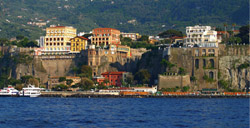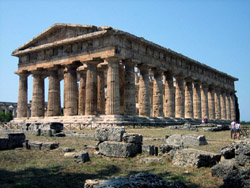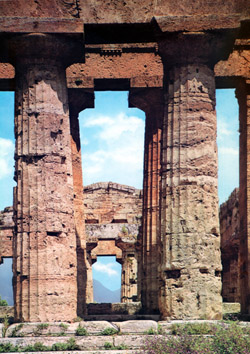
Example of Sorrento inlaid wood work

The coast in volcanic rock of Sorrento

The so-called Basilica at Paestum at sunset

Temple of Neptune at Paestum

Temple of Neptune at Paestum from the
west side
DURATION: |
7/8 hours | |
PRICE: |
Euros 250 | |
AVAILABILITY: | All-year-round | |
| A private tour on foot with a professional guide (only for You) of Sorrento center, the archaeological area and the Museum of Paestum. ENTRANCE FEES OF RUINS AND OF THE ARCHAEOLOGICAL AREA OF PAESTUM ARE NOT INCLUDED. ADMISSION FEE: Adults 4,00 euro EU Citizens: under 18 free 18 > 25 -50% over 65 free The combined ticket of the archaeological area + the Museum costs Euros 6,50 per person. The National Museum of Paestum is closed on the 1st and 3rd Monday of each month. | |
Itinerary Details are listed below:
TOUR SCHEDULE OF SORRENTO AND PAESTUM - TEMPLES AND MUSEUM
|
| Meet with Your personal English-speaking guide by Your hotel or cruiseship |
| Transfer to Sorrento and 1 h walking tour with the guide |
| 1 h free time for exploring Sorrento on Your own |
| Transfer to Paestum and free time for a snack |
| The visit in the archaeological ruins lasts roughly 60 minutes |
| 30/40 minutes will be spent with Your guide in the nearby Museum |
| Back to the hotel or cruiseship |
This trip is a nice combination of a scenic tour (to Sorrento) and an archaeological tour (Paestum).
Sorrento is small town wonderfully located over white steep cliffs and offers a fantastic view over the Bay of Naples. It lies on a tufa terrace and is enclosed by impressive rocks of the limestone mountains. For 2000 years already visitors from all over the world have been attracted to Sorrento by breathtaking sunsets and fragrances of orange and lemon gardens.
After the visit of Sorrento and the transfer to Paestum, you can have free time there for a snack: it is a great solution because there (and only there) you can try a buffalo mozzarella cheese.
After that the guided tour of Peatum can start.
Paestum was founded by Greeks around 600 b.C. At the beginning it was called Poseidonia, since it was dedicated to Poseidon (the Roman Neptune), the god of the sea. In 400 B.C. it was occupied by the Lucans, an Italic populaton. The Lucans ruled it till 273 B.C., when it became a Roman colony and was called Paestum.
The fall of the Roman Empire meant also the decline of Paestum. As matter of fact, around 500 B.C., since the mouths of the rivers running in the plain were silted up, the whole area became quite unhealthy. Malaria had already spread all over the place and even the built-up area became marshy. Consequently the population gradually left the town. In conclusion, such a disaster was caused by the deforestation of the nearby hills.
Actually, these magnificent ruins were preserved by marshes and woods, which prevented them from being destroyed and ransacked for many centuries.
Paestum was rediscovered just by chance in 1752, when they were building the modern road cutting the ancient town into two parts.
Of particular interest are the Greek temples of Paestum, and above all the Temple of Neptune.
THIS PRIVATE TOUR IS NOT AVAILABLE ON THE FIRST AND THIRD MONDAY OF EVERY MONTH, CLOSING DAY OF THE NATIONAL ARCHAEOLOGICAL MUSEUM IN PAESTUM.
SUGGESTIONS:
Take water, wear comfortable shoes, take camera & sun cream. In low season warmer clothing may be required.